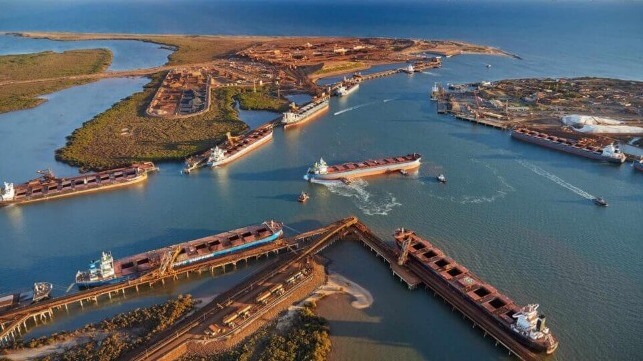Ammonia-Fueled Bulkers Could Start Australia's Green Corridor by 2028

A feasibility study on the potential for the Australia-East Asia Iron Ore Green Corridor concludes that the components are in place to see the first ammonia-fueled bulkers deployed by as early as 2028 followed by a rapid uptake in the shipping industry. While they believe there are favorable conditions to support early adoption and to make the corridor a first mover in the industry, they also outline important conditions including the need to develop an appropriate commercial framework.
The study indicates that the core elements for the implementation of a West Australia-East Asia green corridor – including deployment of ammonia-powered ships, access to clean ammonia (as the most likely zero-emission fuel to power the corridor), and the availability of the bunkering infrastructure – are within reach, provided that the safety case for the use of ammonia as a marine fuel is validated and accepted.
Their timeline scenario highlights the potential to introduce the first ammonia-powered vessels on the corridor in 2028 and by 2030 to already have 23 ships in service. It would grow exponentially to 81 ships by 2035, and roughly 360 vessels to meet the scenario. To make this possible, they point to the need to have the design and investment case in place by 2025. Newbuilds they believe would lead the adoption to the mid-2030s before retrofits would also begin to emerge.
The study points to several contributing factors that they believe position this route to become a first mover. They point to plans for abundant green ammonia production with electronic hydrogen as well as blue ammonia with conventional ammonia in Australia. The potential exists to further supplement the supplies with imports if Australian production did not keep up with demand. The analysis also shows that the Pilbara region of Australia is a viable option for bunkering on the route, avoiding costly deviations from the trade route, while Singapore remains well-positioned to serve as a bunkering hub.
They however also caution that the development of suitable engines, technologies, and regulations also need to remain on track to achieve the early deployment of ammonia as a marine fuel. They expect Singapore and Pilbara will be ready to become bunkering hubs by 2027 while pointing out the need to also have IMO safety regulations and standards in place. They also highlight the critical need for crew upskilling to ensure seafarers are trained to operate ammonia-fueled vessels.
The Pilbara region is home to Australia’s largest iron ore mines and exports. In March 2023, the Pilbara Ports Authority reported a throughput of 62.1 million tonnes with the Port of Port Hedland handling three-quarters of the volume. The port had 279 vessels arrive during March and nearly 90 percent of its iron ore exports (40.4 million tonnes) were bound for China. Japan was third in volume just slight behind South Korea, with nearly 2 million tonnes going to each country.
To continue the efforts to develop the green corridor between Western Australia, China, and Japan, they are also announcing the establishment of an Australia-East Asia Iron Ore Corridor Task Force to act as a collaborator within the industry. They are calling for policy support with efforts to unlock investments highlighting the excepted cost gap between ammonia and traditional marine fuels and said that collaboration and coordination will be required to make the corridor a reality.
The collation to form the green corridor was launched in April 2022. Major charterers, BHP and Rio Tinto, joined with shipping companies, Oldendorff Carriers and Star Bulk Carriers, to work jointly to develop an operational green corridor for the ore industry shipments. The Global Maritime Forum is supporting and coordinating the efforts.
No comments:
Post a Comment